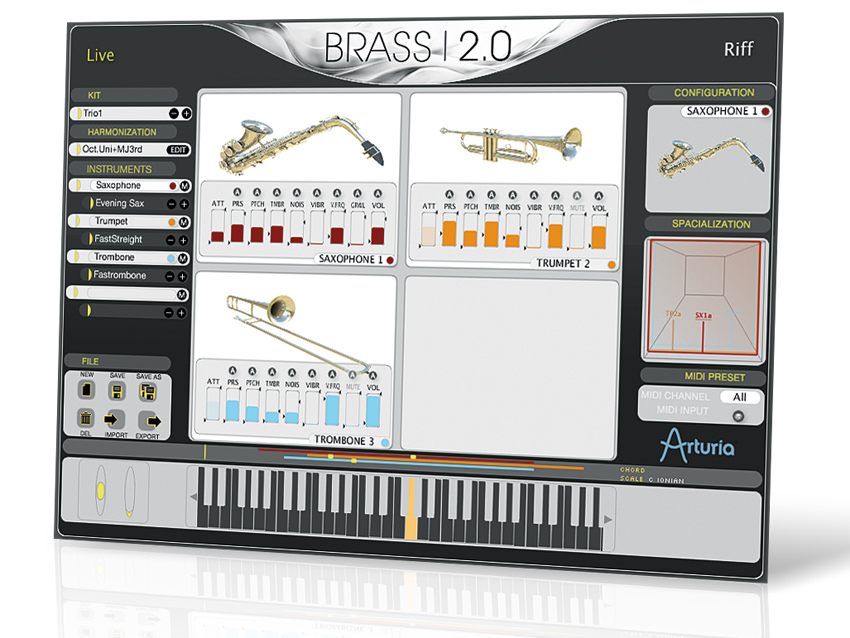MusicRadar Verdict
Brass 2 is smartly presented and sounds decent, but the Holy Grail of realistic brass simulation remains elusive, alas.
Pros
- +
A big improvement over v1. Good trumpet, reasonable trombone. Slick, clear interface. A performance-orientated instrument.
Cons
- -
Unconvincing saxophone. Requires lots of CPU. Steep learning curve to get best results.
MusicRadar's got your back
The original version of Arturia's physically-modelled Brass instrument promised a lot but sounded far too synthetic to be of any real use. Four years after its release, and we have Brass 2 - will it fare any better?
Like v1, Brass includes two modes, Live and Riff, but the former is now four-part multitimbral with a harmonisation feature. Once again, the Riff option includes many programmed MIDI phrases (up to four-part) and, being MIDI-based, you can easily modify overall pitch and tempo, change notes in the integrated piano roll editor or drag them into your DAW.
The three instruments (trumpet, trombone and saxophone) can be loaded in solo form or any combination up to the four-instrument limit, and used in sections or up to four-part unison. What's more, the harmonisation options make doubling up octaves or other intervals simple.
In detail
As we mentioned, Brass 2 uses physical modelling, a synthesis technique that breaks down the instrument and the musician into 'components', virtualising them as mathematical models. If designed successfully, this approach should enable real-time modification, much like a real instrument, and doesn't require a large database of samples.
Research for Brass 2 even involved making an artificial human mouth - this latex creation was used to play a trumpet, so that the developers could analyse the pressures at play in a trumpeter and trombonist's embouchure.
This translates into eight real-time parameters: attack, pressure, pitch, timbre, noise, vibrato, vibrato frequency and mute (with a dynamic model selected). There's also a Humanization slider for real-time variation to the pressure, noise, vibrato and vibrato frequency. There's clearly lots going on, and getting the most out of Brass 2 requires taking control of these variables.
"Research for Brass 2 even involved making an artificial human mouth."
Elsewhere, the MIDI preset window enables flexible assignment of controllers, with curve type and amount for each. Independently of this, you can draw flexible real-time automation for all parameters other than attack.
Want all the hottest music and gear news, reviews, deals, features and more, direct to your inbox? Sign up here.
Rounding things off is the Spacialization page. This is where you level and position each instrument from left to right and near to far, and it includes control over room size and tone.
In use
Unlike articulation-based sample libraries, Brass 2 requires that you instead concentrate on translating brass performance techniques. We tested it using a standard MIDI keyboard and this required using all available MIDI controllers (velocity, pitchbend, mod wheel, aftertouch, expression, etc) to get a decent performance.
We feel that it works well for the trumpet, OK for the trombone and not so great for the saxophone. Using a breath controller or a full-on wind controller would no doubt help, but we suspect that most users will plan to use a regular MIDI keyboard, or program parts in directly.
We were able to generate dynamics, falls, subtle bends and major timbral changes by selecting mutes/mouthpieces. Even so, certain articulations (flutter, for example) eluded us, and it has to be said that the best sample libraries deliver these simply and convincingly. As for combining instruments, we found it best to keep it varied, as stacking the same types of brass sometimes sounded 'phasey'.
The Riff Mode includes almost 200 looped riffs, and the flexibility to change tempo and pitch, or drag them into the DAW, will appeal to programmers. However, the more complex four-part ones took their toll on our CPU meter.
Summary
Brass 2 is more suited to performance than programming, and we applaud Arturia for still pursuing the physical modelling dream. Even so, Wallander's WIVI has shown that other synthesis methods can also deliver playable - and more realistic - brass instruments without resorting to massive sample sets or a large CPU hit.
Our Brass 2 audio demo contains:
1. Trumpet: two examples of standard trumpets then two with mutes
2. Trombone: same example, this time with trombones
3. Saxophones: 2 saxophone examples - classic then jazz mouthpiece
4. A few multipart examples from the riff library
Computer Music magazine is the world’s best selling publication dedicated solely to making great music with your Mac or PC computer. Each issue it brings its lucky readers the best in cutting-edge tutorials, need-to-know, expert software reviews and even all the tools you actually need to make great music today, courtesy of our legendary CM Plugin Suite.

